Kathmandu
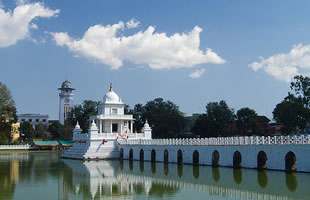 Kathmandu, the capital and the largest city of Nepal, was built by Gunakam Dev in 723 B.S. It derives its name from Kasthamandap or ‘House of Wood’ a pagoda-style temple near Hanuman Dhoka. It is also known as the home of thousand temples. Few steps away, there is the temple of the Living Goddess, where the clients may catch a glimpse of the Kumari at one of the open windows overlooking the inner courtyard. All around the splendor of historical monuments is the hustle & bustle of the market place. Vegetable vendors, trees of flutes, salesmen with their wares displayed on their person, souvenir hawkers, and street shop selling imported goods and tucked away in a quiet corner the glittering bead market for custom made bead necklaces. Kathmandu, the capital and the largest city of Nepal, was built by Gunakam Dev in 723 B.S. It derives its name from Kasthamandap or ‘House of Wood’ a pagoda-style temple near Hanuman Dhoka. It is also known as the home of thousand temples. Few steps away, there is the temple of the Living Goddess, where the clients may catch a glimpse of the Kumari at one of the open windows overlooking the inner courtyard. All around the splendor of historical monuments is the hustle & bustle of the market place. Vegetable vendors, trees of flutes, salesmen with their wares displayed on their person, souvenir hawkers, and street shop selling imported goods and tucked away in a quiet corner the glittering bead market for custom made bead necklaces.
Places to visit:
Kathmandu Durbar Square (World Heritage Site)
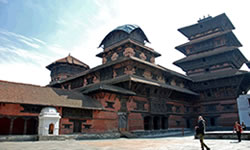 Kathmandu Durbar Square is in the heart of old city Kathmandu in Basantapur. The complex was residence to Nepal's royal family before the construction of the Narayanhiti Palace. The founding of the Palace dates back to Lichhavi times. With considerable renovations by Malla rulers and later the Ranas, construction was accomplished progressively over many centuries. Kathmandu Durbar Square is in the heart of old city Kathmandu in Basantapur. The complex was residence to Nepal's royal family before the construction of the Narayanhiti Palace. The founding of the Palace dates back to Lichhavi times. With considerable renovations by Malla rulers and later the Ranas, construction was accomplished progressively over many centuries.
There are around 50 temples in the vicinity including the temple of titular deity, Taleju Bhawani. The Durbar is divided into two courtyards, the outer comprising Kasthamandap, Kumari Ghar, and Shiva-Parvati Temple, and the inner consisting of Hanuman Dhoka and the main palace. It also houses two museums. Important ceremonies, including the coronation of the Nepali monarch, are held in the Kathmandu Darbar Square. Most parts of the palacepremise are open for tourists throughout the week during office hours.
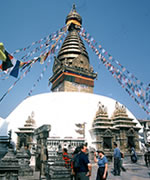 Swayambhunath (World Heritage Site) Swayambhunath (World Heritage Site)
Swayambhunath, a 2000 years old Buddhist monument looking out into the four cardinal directions, is situated on a hilltop overlooking the Kathmandu city. It is one of the world's most glorious chaityas about 3 km from the city center. Surrounding the hemispherical Stupa are many temples and pagodas and large band red-faced monkey, believed to be the descendents of the "Hanuman", the Monkey God.
Bouddhanath Stupa (World Heritage Site)
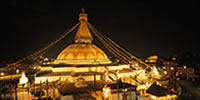 It is a huge Buddhist shrine surrounded by Tibetan shops. It is a dome shaped eight-angled structure with the all-seeing eyes of Lord Buddha looking out into the four cardinal directions. It is built by the Lichhavi King Man Dev in the 5th century. It is one of the biggest stupas in the world of its kind and is just 11 km far from Kathmandu city. It is a huge Buddhist shrine surrounded by Tibetan shops. It is a dome shaped eight-angled structure with the all-seeing eyes of Lord Buddha looking out into the four cardinal directions. It is built by the Lichhavi King Man Dev in the 5th century. It is one of the biggest stupas in the world of its kind and is just 11 km far from Kathmandu city.
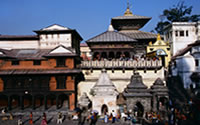
Pashupatinath (World Heritage Site)
Pashupatinath is one of the four most important religious sites in Asia for Shiva devotees. Pashupatinath, dedicated to Shiva the Destroyer, is the holiest Hindu pilgrimage destination in Nepal. Although the Pashupatinath Temple was only built in the 5th century and later renovated by Malla kings, the holy site is said to have existed from the beginning of the millennium.
Budhanilkantha
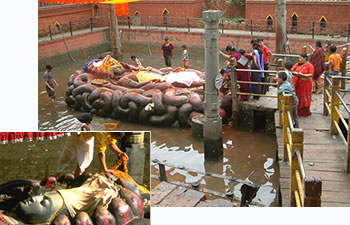 It is the largest and the most important Vishnu shrines in the valley, which is situated at the Shivapuri foothill some 8 km to the north of Kathmandu. The main shrine consists of a giant granite image of lord Vishnu reclining on a bed of coiled snakes in the middle of a pond. Jalasaya Narayan - popularly known as Budhanilkantha is Lord Vishnu for Vaisnavs, Lord Shiva for Shaivas, and Lord Buddha for Buddhists. Buddhists and different sects of Hindus worship this god in the names of their faith. This outstanding artwork of Lichhavi sculptors dates back to 7th century and is the most beautiful among all the stone engravings within the Kathmandu Valley. It is the largest and the most important Vishnu shrines in the valley, which is situated at the Shivapuri foothill some 8 km to the north of Kathmandu. The main shrine consists of a giant granite image of lord Vishnu reclining on a bed of coiled snakes in the middle of a pond. Jalasaya Narayan - popularly known as Budhanilkantha is Lord Vishnu for Vaisnavs, Lord Shiva for Shaivas, and Lord Buddha for Buddhists. Buddhists and different sects of Hindus worship this god in the names of their faith. This outstanding artwork of Lichhavi sculptors dates back to 7th century and is the most beautiful among all the stone engravings within the Kathmandu Valley.
|